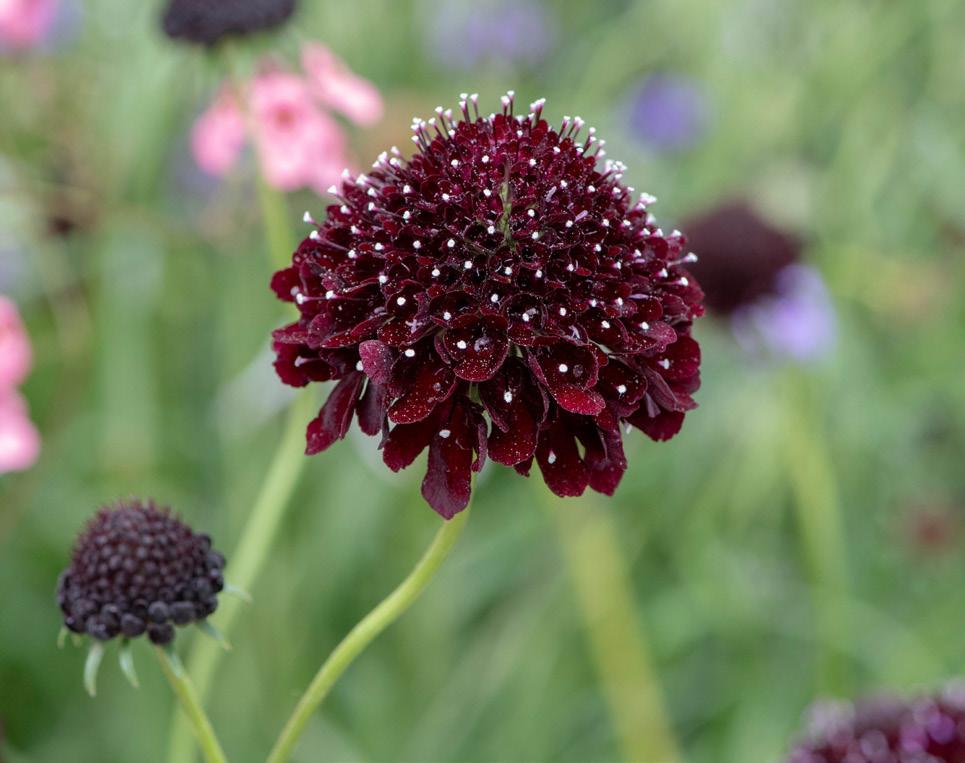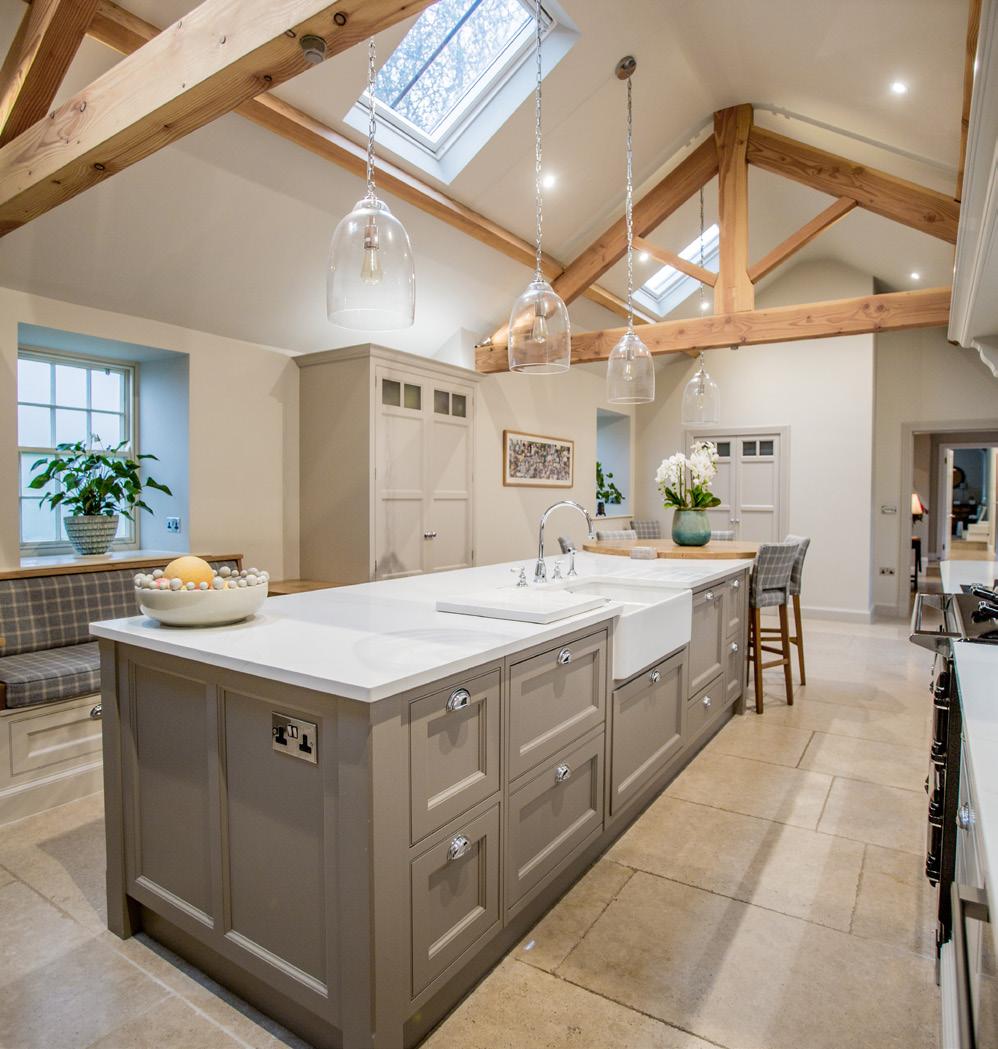
5 minute read
A MATCH MADE IN HEAVEN
by Dales Life
Maroons and lime greens make a captivating combination, says Adam Appleyard

Advertisement
hether it’s outside in the garden or indoors in a vase, some colour combinations really sing. One of my favourite ways of adding pep to a border is to set deep, smouldering maroons alongside fresh, perky lime greens. It’s a bold, confident, sophisticated pairing. And it’s one that – with a little planning – you can use to enliven your garden right through the year.
PARROT TREASURE
A quick and easy way to get your fix of maroons and lime greens early in the year is with a swathe of suitably chosen tulips.
In recent years thoughtful gardeners have gravitated away from the glaring scarlet and yellow tulips that populate so many municipal roundabouts, and opted instead for subtler colours and more varied forms. Tulipa ‘Black Parrot’ is an excellent example. Parrot tulips have wonderfully fringed and ruffled petals, which give them a swaggering air that makes the standard cup-shaped tulip look positively meek. In ‘Black Parrot’ the sense of drama is heightened still further by the dark purple, nearblack colouration of the petals. And what better to set ‘Black Parrot’ off against than the equally distinctive Tulipa ‘Spring Green’? ‘Spring Green’ belongs to the ‘viridiflora’ group of tulips, whose elegant, slightly pointed petals are streaked with bold stripes of vibrant green. In the case of ‘Spring Green’ the green fades gently into a rich, creamy ivory.
‘Black Parrot’ and ‘Spring Green’ are both relatively late-flowering tulips. Plant them together and they should flower simultaneously sometime between late April and the end of May.


OPPOSITE: LEFT Tulipa 'Black Parrot' with Cerinthe major 'Purpurascens' - honeywort, and Nigella foliage. RIGHT Tulipa 'Spring Green'. THIS PAGE: TOP Scabiosa atropurpurea pincushion flower. BELOW Nicotiana alata 'Lime Green' - tobacco plant. OVERLEAF: LEFT Alcea Rosa Hollyhock. RIGHT Molucella laevis 'Bells of Ireland'
HEAVEN SCENT
As spring moves into summer, one good way to mix maroons and limes is to combine the sharp, bright tones of Nicotiana alata ‘Lime Green’ with the deliciously dark-crimson flower heads of Scabiosa atropurpurea ‘Black Knight’.
An added bonus of the Nicotiana is the gorgeous perfume that it – like most kinds of tobacco plant – releases in the evenings to lure night-flying moths.
Scabiosa atropurpurea, also known as sweet scabious, also has a pleasant fragrance, and it’s always popular with bees and butterflies. Deadhead it regularly or cut it back hard in midsummer and it may well carry on flowering from June right through to September.
Both species are annuals, and are easily grown from seed. They enjoy full sun and can happily rub along together in well-drained soil. Even if you choose to grow them apart, they make excellent cut flowers and partner up beautifully in a vase.


DREAMING SPIRES
Alcea rosea ‘Nigra’ (hollyhock) and Molucella laevis (bells of Ireland) are two more plants in the maroon-and-lime arsenal for high summer and beyond – and two highly desirable plants for the flower arranger.
Hollyhocks, of course, are available in a wide variety of colours, but the cultivar ‘Nigra’ is remarkable for its tall spikes of stunning maroon flowers. Like all hollyhocks it prefers a sheltered spot in full sun. It will reach a height of around two metres, and even backed up against a fence or a wall may need staking.
Molucella also produces showy spires, but of tiny, insignificant flowers surrounded by conspicuous yellow-green bracts. It’s substantially shorter than the hollyhock, but the two plants can be effectively paired by growing hollyhocks at the back of the border with stands of Molucella in a mid-border position in front of them.
Molucella is a tender annual but is easy to grow from seed. It doesn’t especially enjoy being transplanted, so either sow in situ or plant out as soon as the danger of frost is past.
IN THE LIMELIGHT
As for summer perennials, Rosa ‘Black Beauty’ and Hydrangea paniculata ‘Limelight' make another fabulous combination, both in the vase and in the garden.
Rosa ‘Black Beauty’ is a repeat-flowering hybrid tea rose with velvety, dark burgundy petals – in fact it’s one of the darkest roses you can buy. In full sun it forms a narrow bush just over a metre high.
Hydrangea paniculata is an altogether heftier shrub, but once again you can ‘stage’ the pairing by growing the smaller plants in front of the larger ones. The lush conical flower heads of ‘Limelight’ are ideal for cut flower displays and can also be dried. Grow Hydrangea paniculata in rich, moist soil in full sun or part shade.
FULL CIRCLE
Finally, if you fancy carrying your maroon-and-lime colour scheme on through winter into next spring, hellebores will fit the bill perfectly.
You can find several gorgeous deep maroon cultivars of both Helleborus orientalis and Helleborus x hybridus. And when it comes to zesty lime green flowers, you can’t beat either Helleborus foetidus or Helleborus argutifolius, both of which have appealingly crisp, shapely evergreen foliage.
Group your hellebores in rich soil in part shade to cheer up the short, dark days with a splendid blast of eye-popping colour.
THIS PAGE: LEFT Rosa 'Black Beauty'. RIGHT Hydrangea paniculata 'Limelight'.


For over 40 years we’ve designed and created bespoke kitchens, interiors and furniture across Thirsk, Yorkshire and throughout the UK. Our skilled craftsmen create unique pieces that are built to last a lifetime. Every one of our designs has unique features – from kitchens with individual style to furniture crafted just for your home. We love to discuss new projects and design ideas. For friendly advice please call us or visit our website.
Unit 1 Concept Park, Thirsk Ind. Est. Thirsk, N. Yorkshire YO7 3NH 01845 523562 grovehouseinteriors.co.uk










